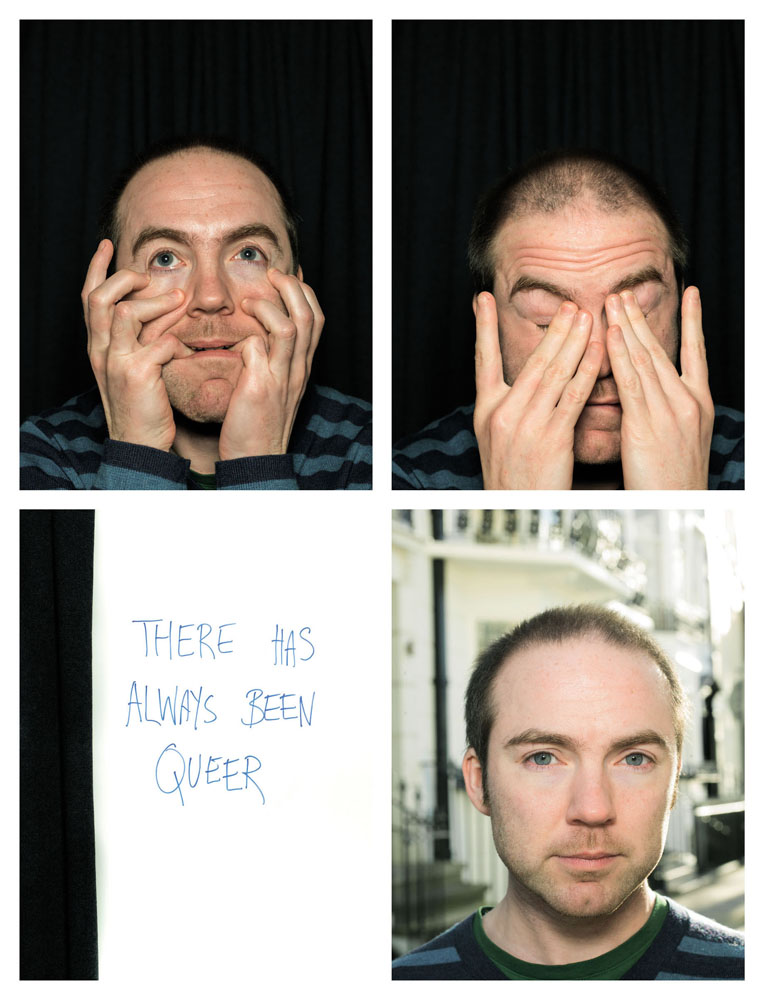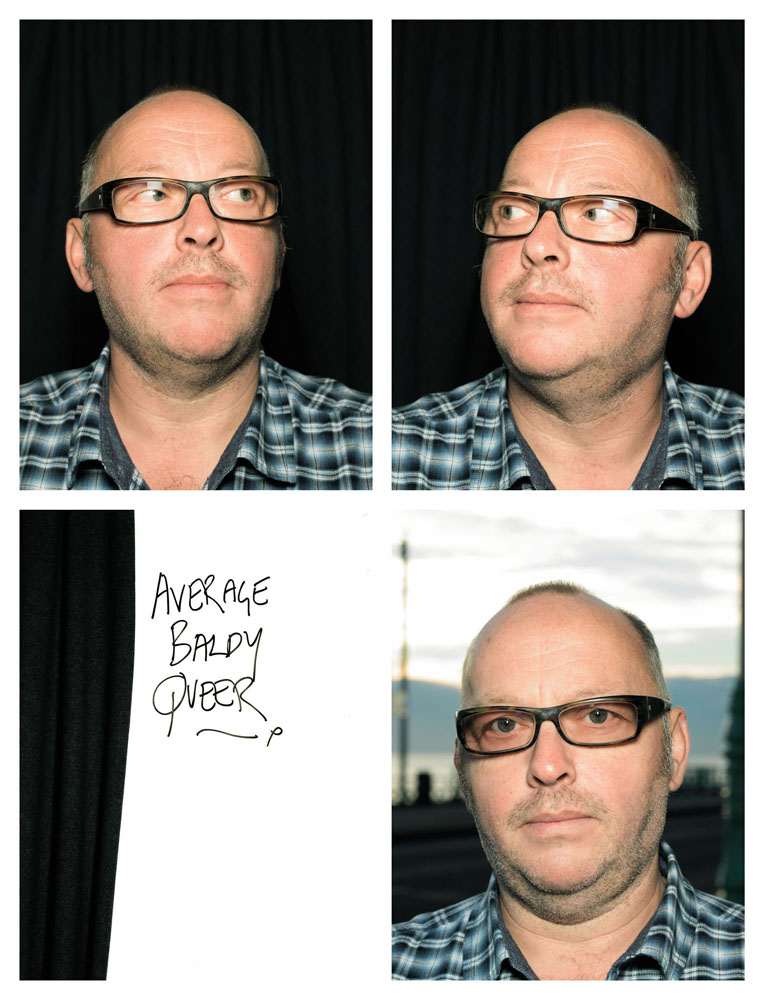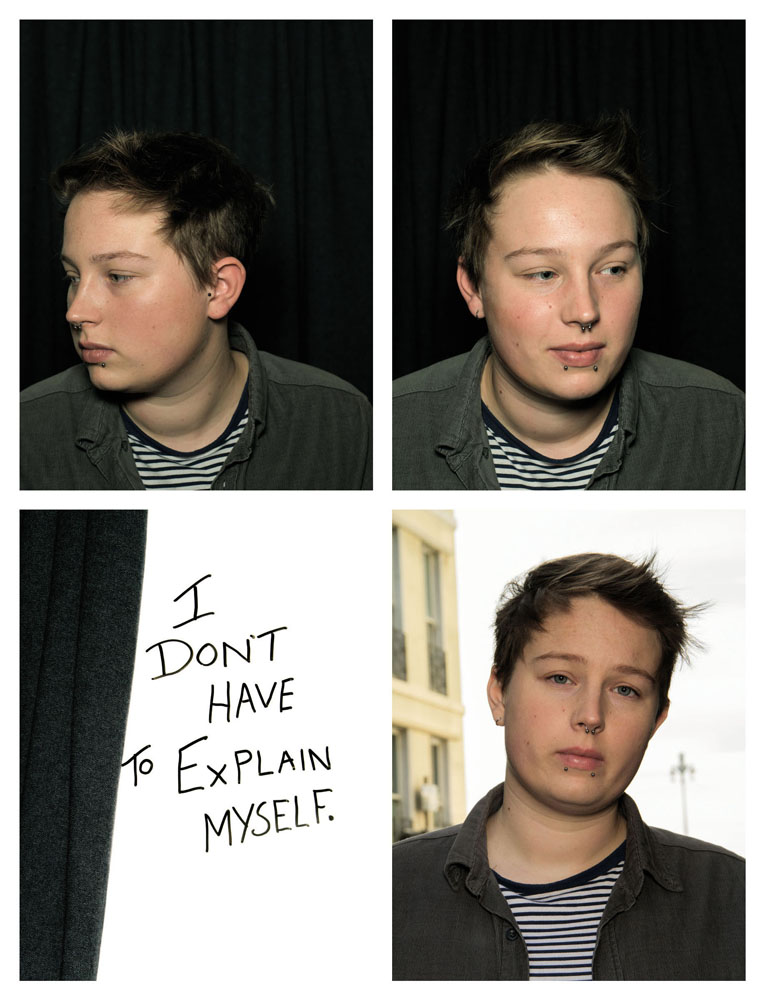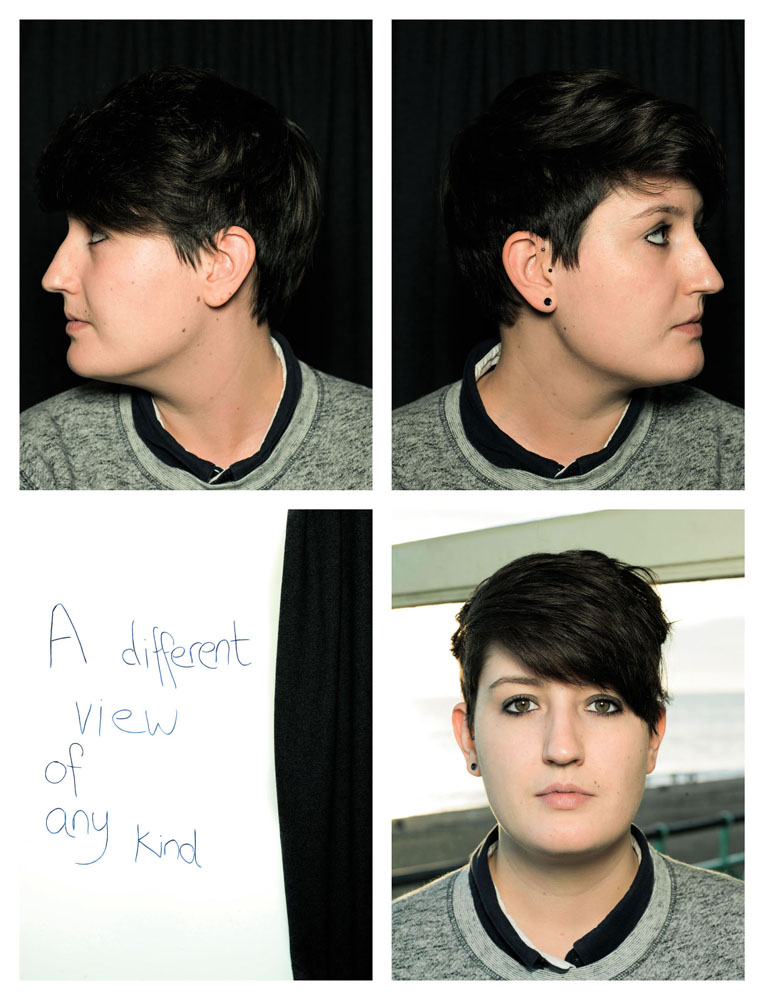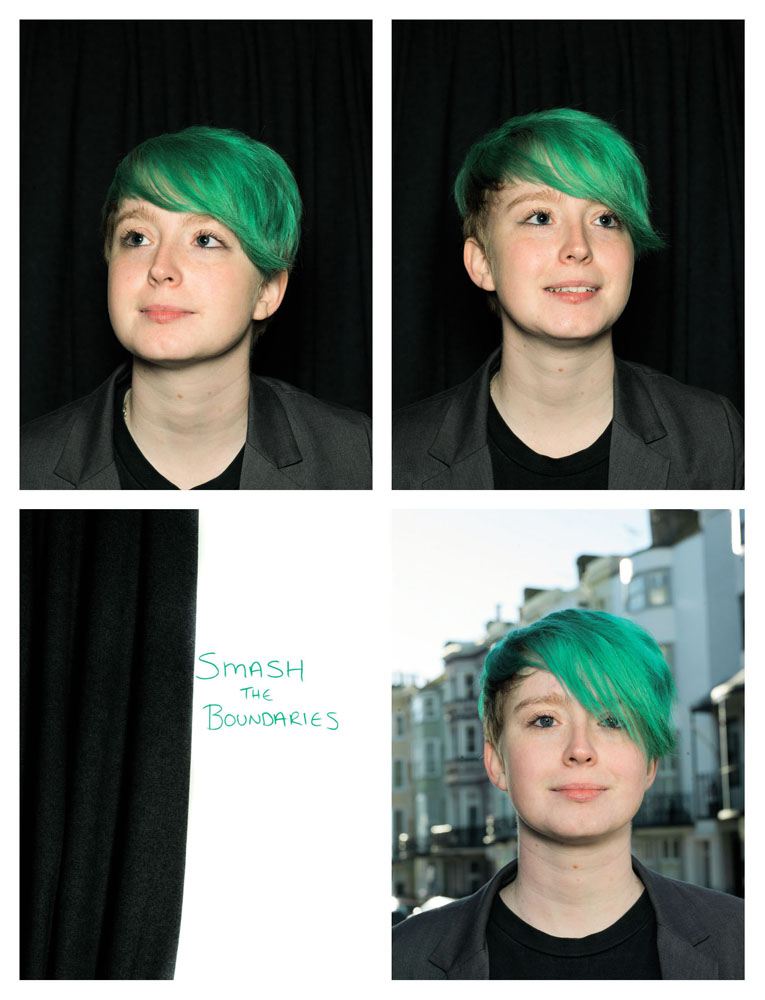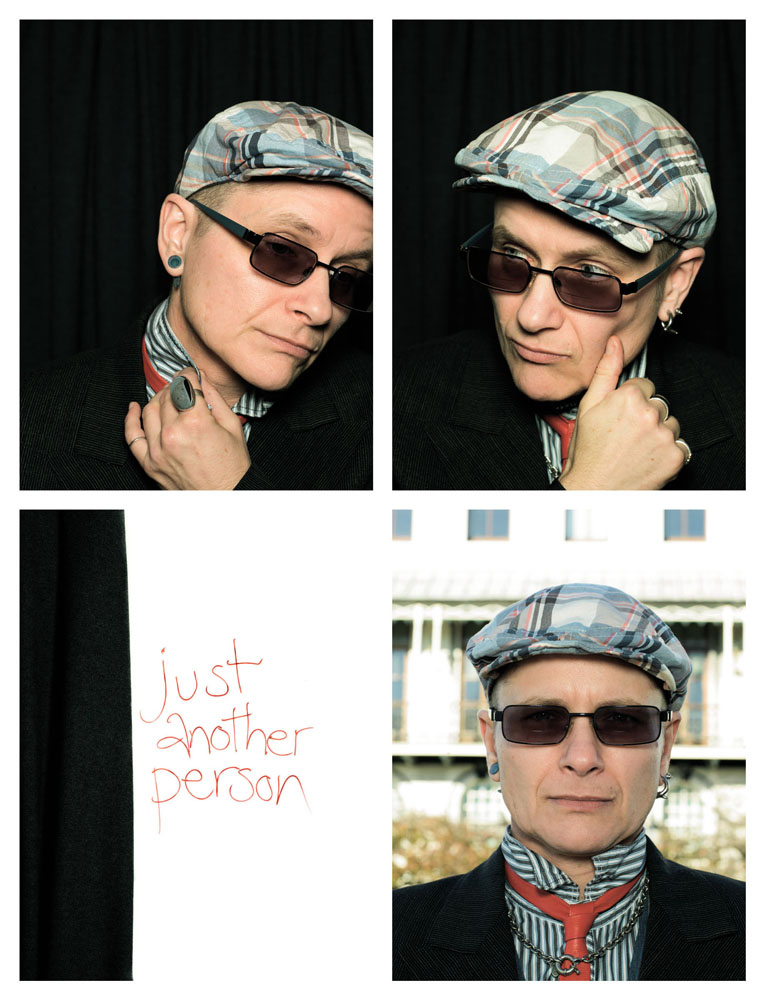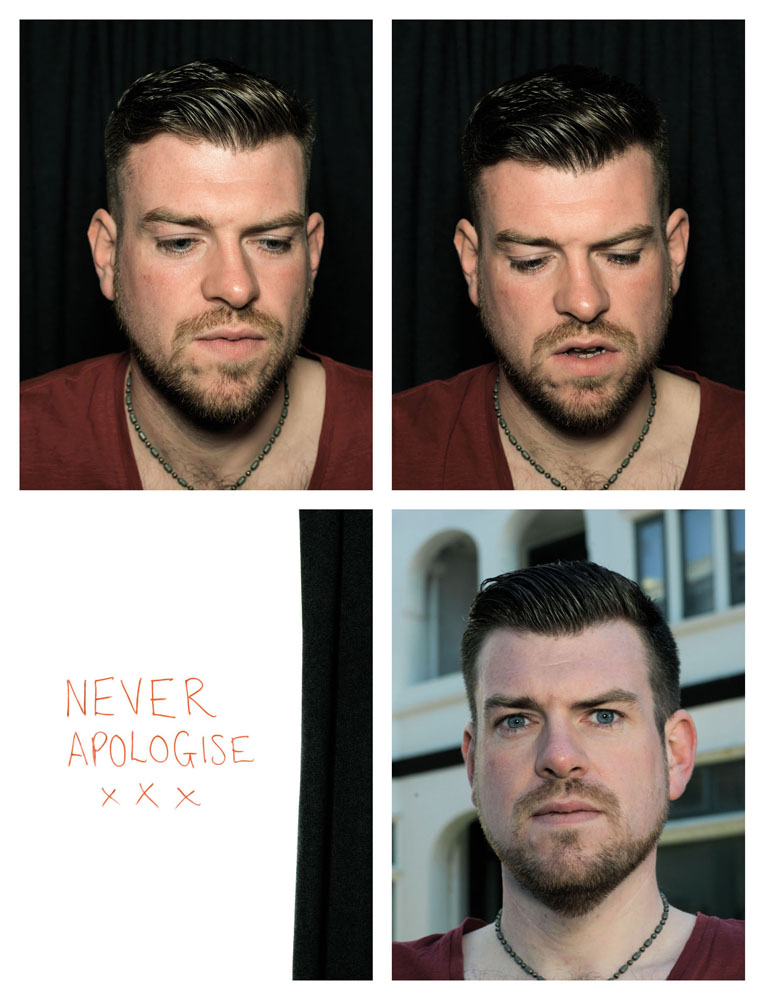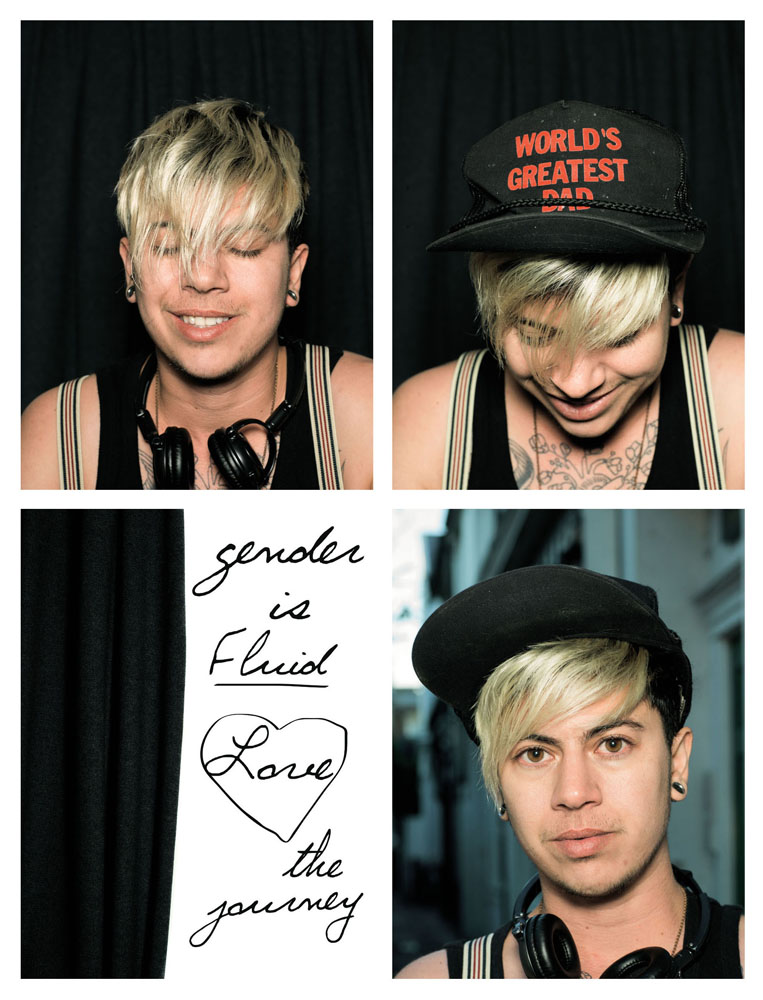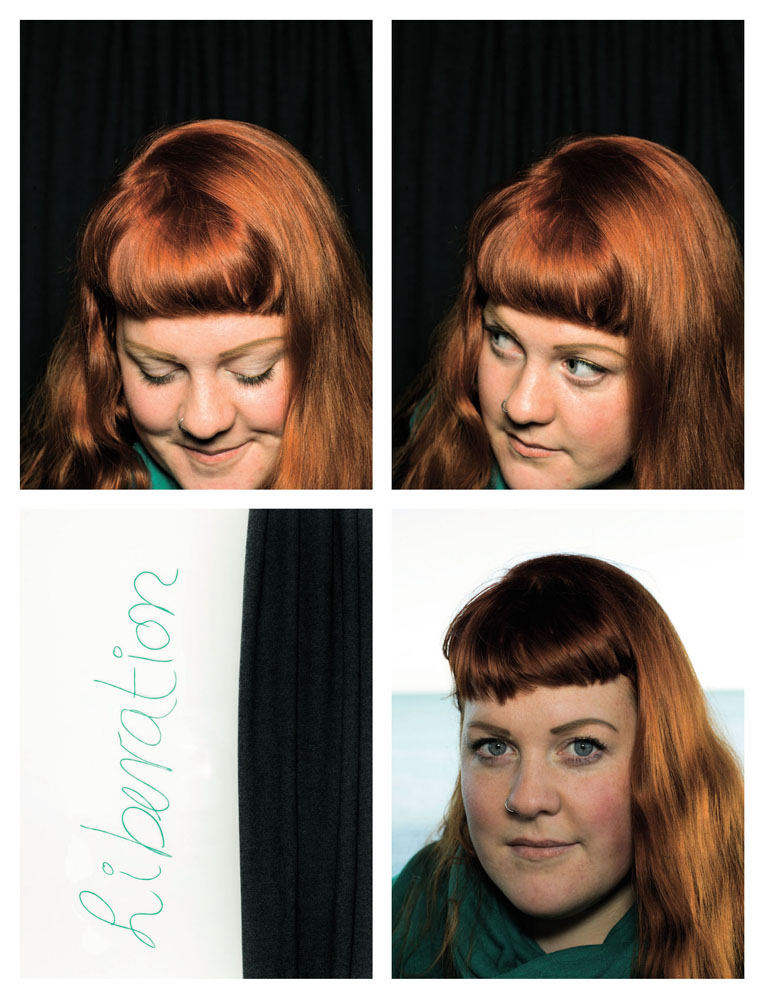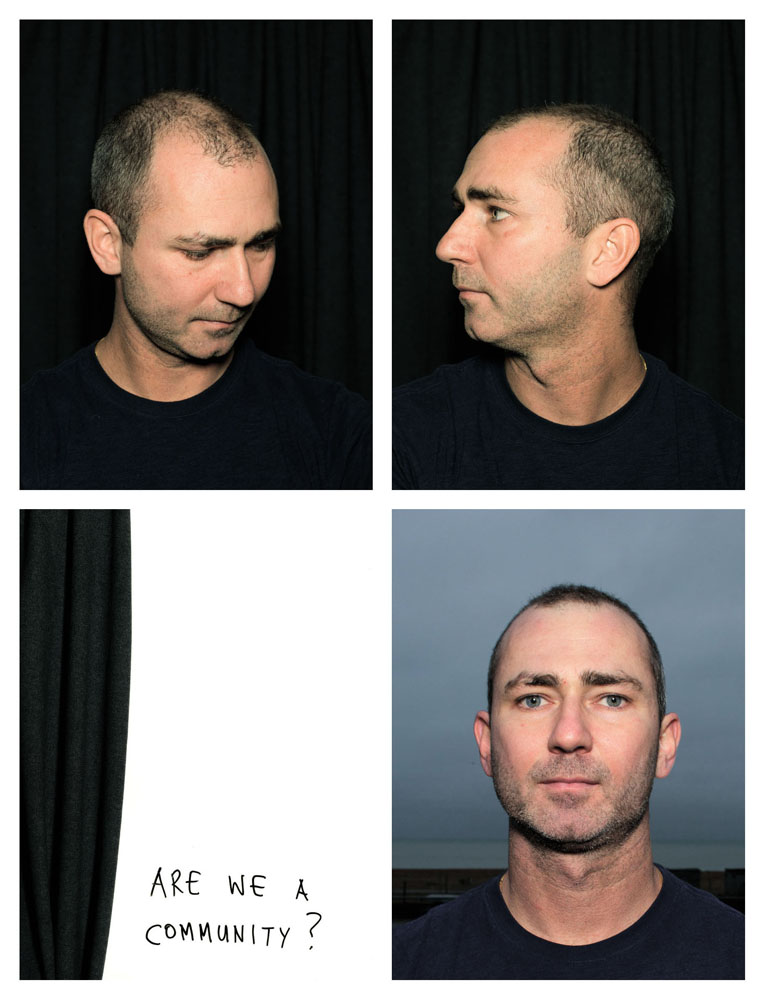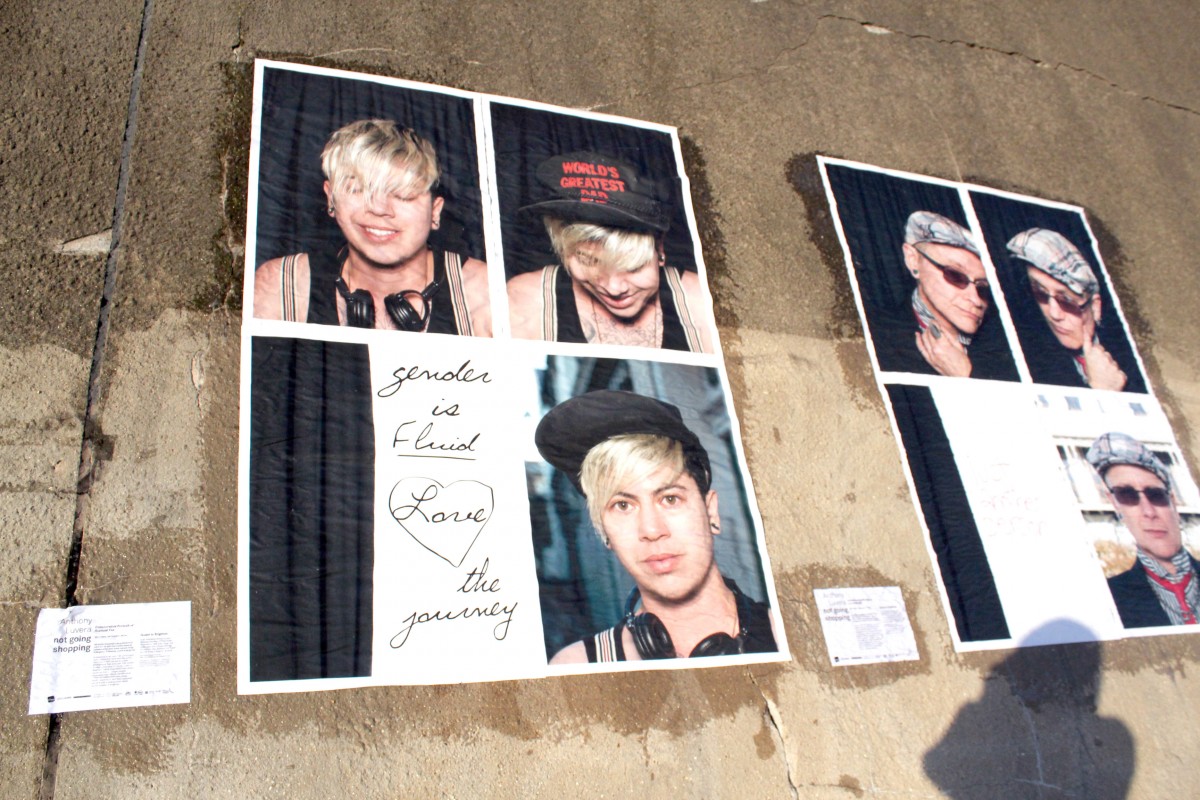Patrick Fox, director of Create, talks to Anthony Luvera about his collaborative project not going shopping for Queer in Brighton.
Patrick Fox: Tell me about the invitation to collaborate. How did it come about? What form did the invitation take?
Anthony Luvera: I was invited to create work with lesbian, gay, bisexual and trans* (LGBT*) people for Queer in Brighton in June 2013. As a gay man, the representation of queer people is often in the forefront of my mind. LGBT* people are largely invisible or misrepresented in the public sphere. The fact that in over seventy countries around the world homosexuality is considered a criminal act – even punishable by death in at least six countries – is appalling and needs to be spoken about much more loudly. Closer to home, I find the disparity between the apparent improvement of the human rights of queer people through same sex marriage legislation and the recent treatment of LGBT* asylum seekers arriving at UK borders very unsettling.
The aim of Queer in Brighton to preserve the cultural heritage of LGBT* people in Brighton & Hove, I believe, is a valuable example of history-telling from the ground up. The activities undertaken by the project – including the recording of oral history interviews and the collection of photographs and ephemera – seemed to fit with my interests in working collaboratively with groups of marginalized people to explore issues related to identity, community, locality and self-representation. I thought the prospect of creating this work could offer a useful way to further my inquiry into collaboration and at the same time provide an opportunity to confront my own views of queerness.
PF: How was your first meeting as a group? How did you feel? What did you observe? What did you learn?
AL: I organized an open call to go out through local organizations and received emails from individuals expressing interest in taking part in working with me. I was conscious I’d be bringing together a group of people who may not know each other and who could have differing opinions about all kinds of things, least of all what it is to be queer. I invited them to meet to find out more about my practice and the work I planned to undertake, and I asked that they bring along three photographs that somehow told their story. I wanted to find a way to strike up conversations about photography and identity, and for us all to begin to get know each other a little. The participants seemed to give this task great deal of thought, bringing images that were meaningful to them. Their photographs not only spoke about the interests, experiences, people and places of importance to them, but also told much about how photography figures in their lives. This activity set up an atmosphere of openness and conversation, enabling the discussions that formed our work together to begin to flow. I provided digital cameras to be taken away to photograph in between our meetings and we discussed my aim to create collaborative portraits over the coming months.
PF: Was it important that it was an ‘elective community’? Quite often with collaborations there is an interface / mechanism that links the artist to the community (a local organization, a service etc). Was the fact that this was a self-identified group important, and did it change things?
AL: I often embed myself in an organization over a period of time in order to meet the people I’d like to invite to work with me. However, when planning to create not going shopping I was keen to invite people from a range of backgrounds and ages, and advertising widely through a number of networks seemed a good way to attract a diverse group of people. I also thought that by having individuals present themselves, this could attract people who would be comfortable in speaking out in public about being queer.

Documentation of not going shopping by Anthony Luvera, 2013-2014
PF: Tell me about collaboration in relation to your practice. What does it mean to you as an artist to work with others in the realization of work?
AL: Collaboration has been key to my work with photography for almost fifteen years. For me, collaboration is about exploring the points of view of the people I work with alongside my own. In doing so I’m interested in the implications this can have on issues to do with agency, representation, authorship and reception.
Amongst other things my take on collaboration is informed by an interest in critiques of documentary representation, research methodologies of the social sciences, process-based art practices, and critical writing about pedagogy, participation and community. The work of writers and artists such as Jo Spence, Allan Sekula, Martha Rosler, A.D. Coleman, Abigail Solomon-Godeau, Johannes Fabian and Ariela Azoulay, appeals to my thinking about the power relations of photographic practice. I am also particularly interested in the activities of individuals and grassroots organizations involved in community photography and the critical debates this work engenders around the politics of representation.

Documentation of not going shopping by Anthony Luvera, 2013-2014
I’ve always been intrigued by how the double-edged definition of collaboration – to unite in labour and to conspire with an enemy – chimes with the problems of photographic representation. It seems to me a large part of the difficulty of collaboration in photographic practice is in the potential pitfall of paternalism. For regardless of how much more involved the subject is allowed to take part in the creation of representation, authorship can only be filtered through the singular voice of the artist or organization. Real collaboration by an artist with his or her subjects would be equal to collectivism or co-authorship, which is impossible outside of a partnership of peers who co-join equally in the ambition, realization and responsibility of a project at every stage, from commissioning and production through to dissemination and reception. It would be disingenuous to present the work I do as a purely collective endeavor.
One of the challenges I’ve faced is in how some of the organizations I have worked with attempt to skew the perception of my practice as a kind of authorless project produced by the organization. This seems largely to do with leveraging marketing and funding opportunities for the organization in the guise of corporate social responsibility, and is often undertaken with little critical rigor or ethical interest. In a time of collapsed public spending on the arts it seems this is becoming more common as organizations increasingly become reliant on funding generated from participation projects in order to support core staffing costs and the running of a main programme. Collaborative artists need to navigate the potential pitfalls of this kind of instrumentalization carefully, which isn’t always easy given the power differential between artists and organizations.

not going shopping Anthony Luvera, poster installation, Brighton & Hove UK, February 2014. Photo by Sarah Dickenson
PF: For me the idea of collaboration challenges the notion of the artist as a solitary figure locked in a room waiting for inspiration to strike, and instead places the artist at the heart of civil society. Photography, as a medium, can be quite a singular form, so I’m intrigued by your approach to collaborative portraits. Could you tell me a bit more about that as a process?
AL: I think you’re right, photography can often be seen as a singular form, but the creation of photographs is always dependent on social relations and temporal processes, even if these aspects of the practice are not immediately evident in the work or communicated by the artist. I am just as interested in the process of working with participants as I am in the photographs and other material that is produced.

Documentation of not going shopping by Anthony Luvera, 2013-2014
When I first met with the participants of not going shopping I discussed my intention to create collaborative portraits. Although I didn’t know exactly how this would take place, I knew that by meeting regularly and developing our conversations a process for making the portraits would begin to take form. We continued to talk about this over the coming months and to test out ideas. At one of the group meetings, a participant brought in a black and white photo booth portrait to show me. Intrigued by the image I suggested we all go and use a photo booth. I was inspired by how in the context of our discussions about photography, identity and queerness, the photo booth – with its associations with the production of images for official identification purposes – could provide a framework with which to develop our conversations further. We began using the photo booth regularly and I brought in high-end digital equipment and materials with which to create our own photo booth images. Over the following weeks I showed participants how to use the equipment and together we created portraits of each other and the photo booth wall. The participants then told me their preferences for which images would be available for me to use.
PF: Quite often the artist is the ‘foreign body’ in terms of the community or context with which they collaborate or in which they work. As a gay man working with lesbian, gay, bisexual and trans* people in Brighton to create work about being queer, did you feel an additional sense of responsibility? Did this differ from other projects?
AL: I think being gay enabled me to take part in discussions in ways that I may not have been able to otherwise. This was different to other projects where I’ve not shared the same or similar experiences with participants in quite the same way – such as in the work made with homeless people or Eastern European migrant women. In this sense I feel more inside the work, but in many respects my interest in the problems of representation and the sense of representational responsibility is the same.
PF: You mention the first same sex weddings taking place in the UK in March 2014, and as I grapple with this work my mind immediately brings into focus the Winter Olympics, the recent controversy over New York’s St. Patrick’s Day parade, and here in Ireland (from where I write this) a recent video by a prominent Irish Drag Queen, Panti Bliss, on the stage of Ireland’s national theatre which has just gone viral, in which she lambasts Ireland’s national broadcaster for censorship, and discusses the ‘self censorship’ which we as a gay community employ on a daily basis, sometimes consciously, sometimes unconsciously as a ‘survival’ mechanism. How did you as a group feel about the unenviable task of representing queerness in this particular moment in history?
AL: The representation of queer people and the publicity surrounding events taking place locally and further afield – including the inaugural Brighton Trans*Pride, the recriminalisation of homosexuality in India, and other events, including those you have mentioned – fuelled our discussions about the continued necessity and value of speaking out about being queer now. I think we also recognized that we could speak best about our individual and collective experiences rather than try to make broad statements about queerness and history. In our first meeting a discussion emerged about how as a representation of queer we were incomplete in all kinds of ways, not least because there were no Black, Asian or minority ethnic individuals, trans women or people who identify as bisexual among us. Although I wanted to work with people from diverse points of view, attempting to bring every shade of queer people together wasn’t my intention.
PF: There seemed to be an intensely dialogical component to this project, with the end result being the more traditional art object but can you tell me for you as an artist, when did the ‘art happen’? (Yes, I’m being provocative here). I suppose what I’m trying to ask is that when an audience receives this work they are met with one moment of a complex and quite often lengthy collaboration, how do we place value on the process – the no doubt endless cups of coffee, the sharing of stories and the trust built over the course of this project? Is it important that there is a value placed upon it?
AL: Any outline of a collaborative practice, by the artist or participant, and especially by an outside observer, will always unavoidably be reductive to some degree. But it is important that there is value placed upon this aspect of the work. For me, the process is as much the ‘art’ as the objects that are created or displayed to the public. In this sense I’m keen to seek out different contexts to present different aspects of the work I undertake. For instance, throughout the process of making not going shopping, a public blog was kept from the first meeting through to after the exhibition. 4,000 copies of a 16-page newspaper, containing excerpts from the public blog and our private Facebook discussions alongside documentation of the making of the Collaborative Portraits, were distributed free across Brighton & Hove. The Collaborative Portraits were displayed on large-format posters in outdoor public spaces across Brighton. In addition, photographs made by participants and the Collaborative Portraits are featured alongside excerpts from oral history interviews and ephemera related to the cultural heritage of LGBT* people in the Queer in Brighton anthology which I co-edited with Maria Jastrzebska. Each of these different presentations show various aspects of not going shopping and the process that forms the work. The Collaborative Portraits are only one aspect and wouldn’t exist had the process not unfolded in the way it did.

not going shopping Anthony Luvera, newspaper, Brighton & Hove UK, February 2014
PF: In his writings on collaborative or dialogical arts processes, the art critic Grant Kester talks about a crisis of criticality. He contends that we’ve not found an adequate way, or the right critical registers to be able to discuss work such as this in a way that befits it’s complexity – he argues that we simply revert to a solitary focus on the art object. That is not to discount or diminish the exhibited work, because it is stunning, moving, fragile, poignant, political, confrontational and tender, but is this tension something you are aware of?
AL: Absolutely. It seems to me a different set of questions needs to be asked when considering collaborative or dialogical work, or however a practice founded on process or participation is labeled. When material generated from these kinds of practices is disseminated publicly outside the context of the group of people involved in its creation, I think it must be viewed foremost as a practice of representation that is framed or relayed in some way and not simply as the display of an unmediated point of view or reality. Consideration of issues around intention, context and representation become particularly heightened, especially with projects that involve children or other ‘spoken for’ or disempowered individuals.

Documentation of not going shopping by Anthony Luvera, 2013-2014</font size>
PF: On a completely different note I want to talk a little about social media. Facebook seemed to be an interesting tool for discussion and debate between everyone involved. I noticed that design considerations like typography for example were almost put up for public vote – democracy in action! Was this a conscious decision or did it evolve organically?
AL: I was interested in exploring how social media could extend conversations and develop a sense of community between the participants and me. Facebook enabled information to be shared and decision-making to be opened up amongst us in between meetings, and this shaped the work in all kinds of ways. I thought the use of social media and blogs could also provide useful tools for representing process by incorporating the participants’ observations, feelings, questions and points of view, while the work was being made and when it was presented to the public.
Documentation of not going shopping by Anthony Luvera, 2013-2014
PF: Did you and the group talk about the reception of this work? The ‘reveal’ can be quite a nerve-wrecking process, especially with it being as deeply personal as it is? Did you as a group, discuss this?
AL: We talked about the exhibition throughout the process of working together. I specifically made a point of asking participants individually if they were sure they were happy to have their face out there in such a public way. I tried to impart as much information about the exhibition as possible and to involve participants in its production throughout the process. This included brainstorming and locating sites for the posters to be displayed in, composing text for the interpretation panel, installing the posters and taking part in television interviews about the exhibition.
In being displayed out in the open, we discussed how the posters might be damaged by weather or the public. When some of the posters were apparently torn down, the participants exchanged their thoughts in the Facebook group and wrote about it on the blog. Harry noted, “although this is regrettable it does demonstrate that they been seen and engendered a reaction”. Ed wrote, “Our posters are being torn in interesting ways – it was hard to not be a little upset but I don’t reckon it was a homophobic attack, but more that its just too tempting when you see a corner of paper! I went out and saw the ones in the West St tunnel and the Thistle Hotel today – they look fab! Will blog and keep a photo record of their wear and tear – mine already has a pleasing rip across it!” And Luc advised, “Re graffiti: wall paper paste resists pencil, biro, gel pen & permanent ink marker!! Take a sharp pointy thing in their stead…”
While galleries can often speak to a consensus, all work exhibited in the public domain takes risks by communicating to multiple audiences. I think this is what makes it an exciting and valuable way to show the work, and I was pleased the participants saw the potential in this as well.

not going shopping Anthony Luvera, poster installation, Brighton & Hove UK, February 2014. Photo by Sarah Dickenson
PF: In terms of the progression of your arts practice, each collaboration throws up new dynamics, new perspectives and new challenges. What have you taken away from this project?
AL: Each collaborative work I create goes some way to inform the next but not knowing where the process will lead to seems to remain the same every time. The dynamics of getting to know new people and inviting them to find ways to use photography with me, and navigating the agendas of organizations, always throws up new situations to learn from. Along with the experience of having met some great people, whose views about being queer have taught me much about my own in ways I never expected, becoming even more sure of the certainty and uncertainty of process is something else I’ll take away from not going shopping.
